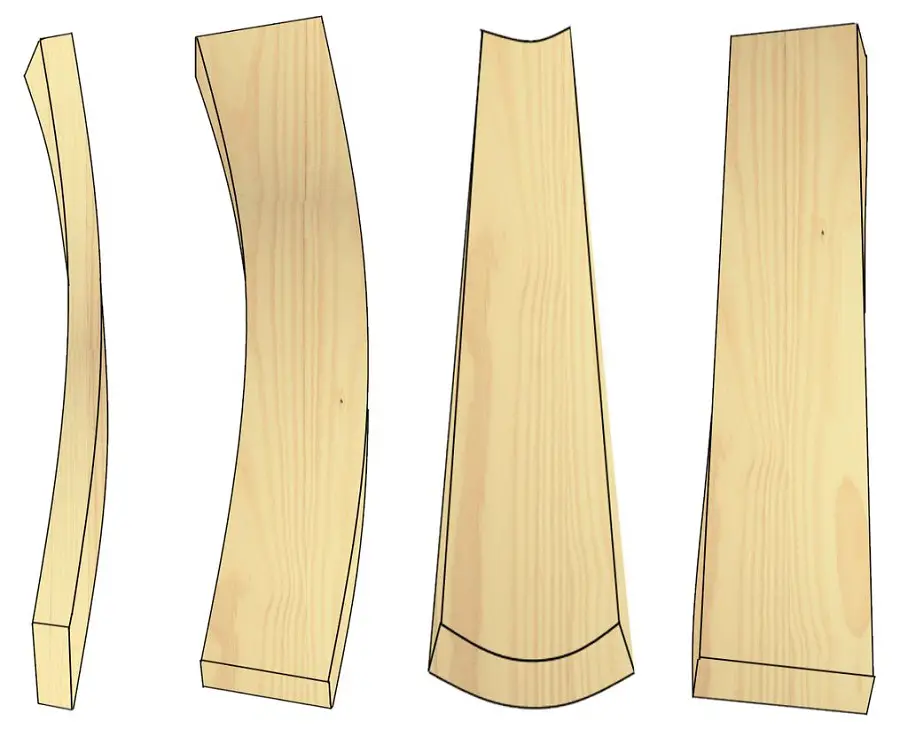I'm sure you've all heard that wood "works" permanently. What does this mean? Solid wood changes its dimensions according to the outside humidity and does this even if it has been properly dried and varnished. The swelling and shrinking of wood occurs because of the exchange of moisture it naturally exchanges with the environment. This is a property that must be taken into account because it has consequences that can sometimes be very unpleasant.
Wood movement. Relationship between wood moisture and environmental moisture
About equilibrium humidity I have already touched on the subject of drying solid wood, but I will remind you of a few facts because they are useful in the following explanations. Equilibrium humidity of wood is closely related to the humidity of the environment in which it is used. For this reason, wood, whose moisture content is very different from that of the environment, tends to lose or absorb moisture in order to reach equilibrium again. In addition, wood is a hygroscopic material, which means that it naturally absorbs moisture.
The following relationship has been established between the equilibrium moisture content of wood and that of the environment:
- outside humidity 25% - wood 5%
- outside humidity 50% - wood 9%
- exterior humidity 75% - wood 14%
- outside humidity 99% - wood 28-30%
When wood at equilibrium is moved to an environment with a different humidity, it will absorb or release moisture until equilibrium is restored. This causes swelling and shrinkage of the wood, which can result in dimensional variation, deformation or the appearance of cracks. This is why, for example, solid wood flooring should be left to acclimatize for a few days in the space where it is to be laid before being installed. This prevents gaps or swelling.
Wood swelling and shrinkage
It all starts with the wood's property of absorbing moisture, hygroscopy (or hygroscopicity, according to some sources). The absorbed water binds to the cell walls and changes the dimensions of the wood. Only this type of water - bound water - causes the dimensional change in wood. There is another type of water - free water - which enters the wood without being bound. It fills the existing voids and so, when it is lost, neither swelling nor shrinkage occurs.
The changes due to bound water are different because the inner structure of the wood to which it is bound is also different. Thus the dimensional variation will depend on:
- species
- how to cut the piece
- size of parts
- anatomy of wood
When choosing wood to be used in environments with large variations in humidity (bathrooms, kitchens, pools, saunas) or outsidewe need to take these factors into account.
In terms of shrinkage when bound water is released, there are 3 categories of wood:
- with small shrinkage: nuc, plop, chestnut, tea
- with medium shrinkage: resinous, cherry, birch, maple
- with high contraction: oak, frasin
That's why cracks in beams oak compared to other species. High shrinkage leads to high stresses resulting in cracking. Species in the first two categories are recommended in construction because their dimensional changes have low consequences.
Dimensional variation within the same trunk
The dimensional variation is also different inside a tree trunk. In the axial (longitudinal) direction the variation is very small so that it is not even taken into account by carpenters. However, in the tangential direction (cutting tangent to the annual rings), the variation is very important, reaching 8-91TP33T in resinous trees and 11-12% in deciduous trees. In the radial direction (cutting perpendicular to the annual rings), the variation is half that of the tangential direction.
The dimensional variation with swelling and shrinkage of the wood should be taken into account when cutting lumber.
The least shrinkage is in radially cut lumber - when the annual rings are perpendicular on both sides of the board. Tangential cutting leads to warping when moisture variations occur and a plank so cut will curve like a canopy. The warping is greater the closer the cut is made to the outside of the trunk. The manner of cutting is clearly visible on the end of the plank. If the annual rings show as straight lines, the cut is radial and the change is small. When cutting tangentially, the annular rings are seen as curved lines, which are closer and closer together the closer the cut is to the outside of the trunk.
In terms of part size, a small part absorbs more moisture than a large one. The result is that it will warp more than a large one.

Photo: woodworking.stackechange.com

Photo: woodworking.stackechange.com

Fiber saturation point
I was saying that there are two types of water in wood, but only that bound at the cellular level leads to swelling and shrinkage. The cell wall cannot bind water indefinitely and there is a maximum amount of water that reaches the wood because of its hygroscopicity. This maximum is called saturation point being lower in resinous (25-28%) and higher in foioase (35-38%).
Different value leads to different behavior. Softwood can be cut throughout the year without the risk of large cracks on drying out, whereas hardwood should only be cut outside the growing season (November-January). Deciduous wood should be sliced lengthwise as soon as it is cut as there is a risk of deep splitting, whereas resinous wood can reach equilibrium moisture content as a trunk (see houses in bușteniThe trunks of resinous trees can be peeled immediately after felling without major consequences, while hardwoods should be left in their bark for as long as possible to slow down the water outflow.
Don't get confused between the total water content of fresh-cut wood (35-40% in hardwoods and 50-55% in softwoods) and the saturation point. Only the percentage of water represented by the saturation point produces dimensional changes when it is removed because it is bound to the wood fiber. The escape of this water can lead to stresses and cracking. The faster, the more sudden, the more unpleasant the consequences.
Why is it important to know about wood swelling and shrinkage?
Why have we insisted so much on the swelling and shrinkage of the wood and the consequences of water removal? Because, as I said at the beginning, wood is constantly moving and there is nothing we can do about it. But we can dry it, cut it and assemble it without any consequences of its movements. Problems of dimensional variation can occur with wood used indoors, not just exposed wood. Wherever two differently cut pieces of wood meet, a problem can arise if the wood moves. Those who make doors and windows know this best. The problems are not only related to the increase or decrease in length but also to bending or warping. The wrong choice of joinery can lead to the joints bending and warping and even splitting. The difference between a work that retains its shape and one that warps over time is the correct choice of wood. You can't have good and very good results no matter which wood you use.
I hope you find the above information interesting. If you think it is useful to others, please feel free to share. And if you have any clarifications, additions or questions, please leave them below, in the dedicated space.

































Hello! I have two questions. 1.Does the wood embedded in epoxy resin change dimensionally (I am working on my first countertop of this kind)? 2. If I do a total lacquering (not only on the surface) of a solid wood countertop (also a kind of embedding but in lacquer not in resin and in a thinner layer) will there be dimensional changes if the lacquer keeps its integrity?
Hello!
1. Does not change if fully coated with epoxy resin. This severs all connection with the outside and the moisture inside the wood is no longer related to the outside. This is how a flower or a piece of freshly cut wood can be preserved.
2. If you achieve that total embedment, there will be no moisture exchange with the outside. But it's very difficult with ordinary varnishing. You should give several coats to fill the pores and insulate them and to block the absorption on the fiber ends. The drying and setting of the varnish takes at least 14 days (some sources give 30 days) During this time the varnish is absorbed into the wood, "falls into the pores" as they say. This obsorption can leave some fiber ends in contact with the outside and then all insulation is compromised.
All the best!
you are a BIG help! Thank you so much!
Hello,
What type of wood would be recommended for a wooden joinery? Assuming the wood is properly dried and the workmanship is done correctly. Basically the joinery should last over time, not warp, be moisture resistant, and retain its appearance. Is it possible that the treatments applied to the joinery are more important than the properties of the wood?
Sincerely,
Good evening!
If by joinery you mean windows, first of all laminated wood should be used in order to be as stable as possible, as little influenced by humidity variations. Plain, unlaminated wood is very likely to warp or be affected by moisture.
Softwoods (spruce, pine) are used a lot because wood resin is a factor that increases resistance to moisture and is a lighter wood, it does not load the walls of the house very much. Oak, ash or exotic woods (meranti, mahogany) are also used.
The finish protects the wood from moisture and UV rays, but will not make a piece of lumber behave like laminated wood. The most resistant finishing products are high gloss paints, the least resistant, gloss varnishes. Totally transparent products (without any pigment added to make them semi-transparent) are not sun resistant. The best outdoor products are guaranteed for 8-12 years. However, durability also depends on the area where the house is located (sea, mountains), the cardinal points (north or south facing), the way the house is maintained.
You can also find information about exterior finishing in the link below.
All the best!
https://revistadinlemn.ro/2018/06/25/8-cele-mai-frecvente-intrebari-despre-protejarea-lemnului-la-exterior/
Hello,
I found an error in the text here: "The resinous trunk can be peeled immediately after felling without much consequence, whereas resinous wood is best left as long as possible with the bark to slow down the water outflow." - I think it is "... whereas hardwood ...".
Thanks for the information.
Hello!
Thanks for the reminder.
All the best!